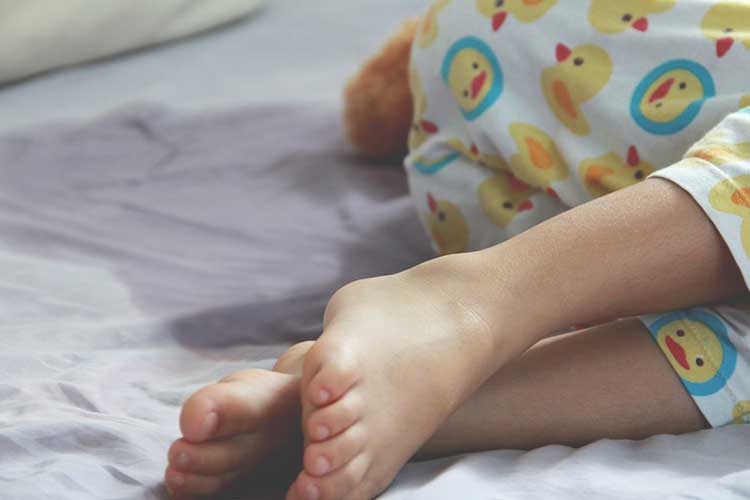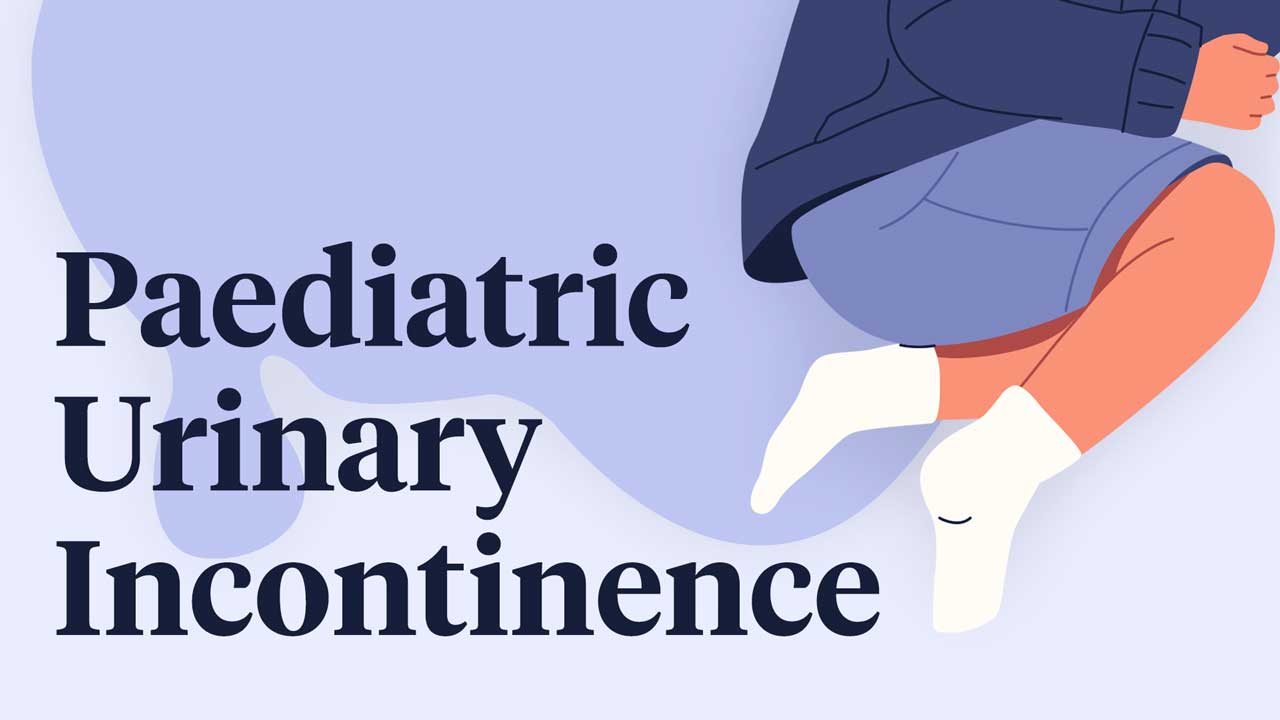Even though paediatric urinary incontinence may be concerning for the child and parent(s) involved, it's quite common – and it’s very likely that you will frequently encounter this issue in your work.
Typically, a child will have achieved daytime bladder control by the age of four (Continence Health Australia 2024). When this doesn’t occur, and a child is still prone to wetting at inappropriate times or during the night, intervention is required.
Urinary incontinence can have a significant negative impact on a child’s psychosocial wellbeing and affect their day-to-day life. Fortunately, there are many treatment options available.
This article will discuss the presentation and treatment of paediatric urinary incontinence.

What is Paediatric Urinary Incontinence?
Paediatric urinary incontinence refers to the inability of a child to control their bladder, which results in wetting (Continence Health Australia 2024).
Children usually attain continence during the day by the age of four. Nighttime continence usually takes longer to achieve and generally occurs by the age of seven or eight (Continence Foundation of Australia 2022, 2024).
Note: These age indicators may not apply to children with developmental delay and are therefore based on children who are developing typically (Figueroa et al. 2025).
Paediatric urinary incontinence is separated into two distinct categories:
- Diurnal enuresis (day wetting): When a child cannot control their bladder during the day. It is typically only diagnosed in children over the age of 5.
- Nocturnal enuresis (bedwetting): When a child cannot control their bladder during the night.
(Raising Children Network 2023; Healthdirect 2024)
How Common is Paediatric Urinary Incontinence?
- About 10% of school-aged children experience paediatric urinary incontinence.
- Roughly 1 to 2% of adults continue to experience bedwetting at night.
- Nighttime wetting is twice as common among boys and when there is a known family history.
(Caldwell et al. 2019; Daley et al. 2024)
Physiology of Paediatric Urinary Incontinence
As is understood, the bladder has a dual function: to store and eliminate urine. Paediatric urinary incontinence occurs when the child is unable to carry out the following actions:
- Throughout the day, responding to the sensation of fullness in their bladder, the child will contract their detrusor muscle as they relax their urinary sphincters and pelvic floor muscles – this permits the stream of urine until the bladder is emptied.
- At night, the child should be able to sleep without needing to urinate, but still possess the ability to wake up and void when they sense bladder fullness.
How Does Paediatric Urinary Incontinence Present?
Common problems include:
- Leakage: This occurs when the child is prone to avoiding going to the toilet and wets when the bladder overfills.
- Overactive bladder: The child’s bladder is struggling to store urine. The child may express urgency, urinate while trying to get to the toilet, or need to void up to or more than eight times per day.
- Underactive bladder: The child goes to the toilet infrequently (less than four times a day), and sometimes urine escapes. Urinary tract infections are common in these cases.
- Partial emptying of the bladder: The child has not grasped how to completely empty their bladder.
(Continence Health Australia 2024)
Urinary tract infections, constipation and stress should be considered possible contributing factors to urinary incontinence (Raising Children Network 2023).
Treatment and Management Options
If urinary incontinence is suspected, the child should first be assessed by a general practitioner (GP). The GP will perform a physical examination of the child’s abdomen, lower back and genitals and may also test the child’s urine (Raising Children Australia 2023).
There are several options available for the treatment and management of paediatric urinary incontinence.
The first-line treatment for children with this condition is to ensure the child practises healthy toilet habits such as:
- Drinking fluids regularly
- Going to the toilet routinely
- Being able to recognise when they need to void
- Going to the toilet when they feel the urge to void rather than ‘holding on’.
(Raising Children Australia 2023)
This might involve keeping bladder diaries about the child’s toilet habits (Raising Children Australia 2023).
Other potential interventions include alarm training (placing wetness sensors under the bedsheets or in the child's underpants to wake them up when they are wet) and, in some cases, prescribed medications (RCHM 2020).
Family education about the cause and clinical course of incontinence is important in order to reduce stigma and assist with treatment.

Prevention of Paediatric Urinary Incontinence
Incontinence can, in most cases, be prevented by learning and practising particular healthy habits.
To prevent any form of incontinence, it's important to encourage the child to be physically active, learn and practise good toilet habits, drink plenty of fluids, and overall endeavour to live a healthy lifestyle.
When to Refer
Children may need to be referred to a specialist if:
- They have a suspected anatomical abnormality
- They are experiencing behavioural problems or co-occurring psychological conditions
- They are experiencing haematuria, proteinuria, polyuria or polydipsia.
(RCHM 2018)
Conclusion
Paediatric incontinence is frequently encountered in general practice, as it is a common issue in school-aged children.
Effective treatment is enormously beneficial for the child, their wellbeing and their self-esteem. The stigma surrounding urinary incontinence should not be underestimated.
To determine the most effective treatment and to reach an accurate diagnosis, a detailed examination and assessment of family history are crucial.
Test Your Knowledge
Question 1 of 3
Which one of the following is usually achieved first?
Topics
References
- Caldwell, PHY, Manocha, R, Hamilton, S et al 2019, ‘Australian Community Health Practitioners’ Knowledge and Experience with Managing Urinary Incontinence That Begins in Childhood’, Australian Journal of General Practice, vol. 48, no. 1-2, viewed 21 July 2025, https://www1.racgp.org.au/ajgp/2019/january%E2%80%93february/managing-urinary-incontinence-that-begins-in-child
- Continence Health Australia 2022, Bedwetting in Childhood, Continence Health Australia, viewed 9 July 2025, https://www.continence.org.au/information-incontinence-english/bedwetting-in-childhood
- Continence Health Australia 2024, Daytime Wetting, Continence Health Australia, viewed 9 July 2025, https://www.continence.org.au/incontinence/who-it-affects/children/daytime-wetting
- Daley, SF, Gomez Rincon, M & Leslie, SW 2024, ‘Enuresis’, StatPearls, viewed 21 July 2025, https://www.ncbi.nlm.nih.gov/books/NBK545181/
- Figueroa, TE, DeCotiis, KN & Pekarsky, AR 2025, Urinary Incontinence in Children, MSD Manual, viewed 9 July 2025, https://www.msdmanuals.com/professional/pediatrics/urinary-incontinence-in-children/urinary-incontinence-in-children
- Healthdirect 2024, Bedwetting in Older Children, Australian Government, viewed 9 July 2025, https://www.healthdirect.gov.au/bedwetting-in-older-children
- Raising Children Network 2023, Urinary Incontinence, Raising Children Network, viewed 9 July 2025, https://raisingchildren.net.au/guides/a-z-health-reference/urinary-incontinence
- Royal Children’s Hospital Melbourne 2018, Clinical Practice Guidelines: Urinary Incontinence - Daytime Wetting, RCHM, viewed 21 July 2025, https://www.rch.org.au/clinicalguide/guideline_index/Urinary_Incontinence_-_Daytime_wetting/
- Royal Children’s Hospital Melbourne 2020, Bedwetting, RCHM, viewed 21 July 2025, https://www.rch.org.au/kidsinfo/fact_sheets/bedwetting/
 New
New 
